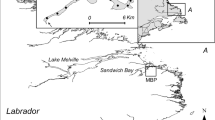Abstract
Radiotelemetry was used to investigate the diel activity pattern of juvenile Atlantic salmon (Salmo salar) in early and late winter. Fish were active throughout the diel cycle. However, there was significantly less daytime than nighttime movement and movement declined significantly with increasing fork length. Maximizing winter growth rate, through an overall increase in foraging activity, may reduce the risk of starvation in smaller fish. The results of the present study provide evidence that the activity patterns of juvenile salmonids are quite complex and support the suggestion that individual variation in activity patterns are, at least, partially driven by body size.
Similar content being viewed by others
References
Adams, N. S., D. W. Rondorf, S. D. Evans, J. E. Kelly, & R. W. Perry, 1998. Effects of surgically and gastrically implanted radio transmitters on swimming performance and predator avoidance of juvenile chinook salmon (Oncorhynchus tshawytscha). Can. J. Fish. aquat. Sci. 55: 781-787.
Anderson, W. G., R. S. McKinley & M. Colavecchia, 1997. The use of clove oil as and anesthetic for rainbow trout and its effects on swimming performance. N. am. J. Fish. Mgmt. 17: 301-307.
Batschelet, E., 1981. Circular Statistics in Biology. Academic Press, New York: 371 pp.
Bradford, M. J. & P. S. Higgins, 2001. Habitat-, season-, and sizespecific variation in diel activity patterns of juvenile chinook salmon (Oncorhynchus tshawytscha) and steelhead trout (Oncorhynchus mykiss). Can. J. Fish. aquat. Sci. 58: 365-374.
Brett, J. R. & T. D. D. Groves, 1979. Physiological energenetics. In Hoar, W. S., D. J. Randall & J. R. Brett (eds), Fish Physiology. Academic Press, London: 279-352.
Brown, L. & J. F. Downhower, 1988. Analyses in Behavioural Ecology, a manual for lab and field. Sinauer Associates, Inc., Massachusetts: 194 pp.
Cunjak, R. A., 1988. Physiological consequences of overwintering in streams: the cost of acclimitization? Can. J. Fish. aquat. Sci. 45: 443-452.
Cunjak, R. A. & G. Power, 1987. The feeding and energetics of stream-resident trout in winter. J. Fish Biol. 31: 493-511.
David, B. O. & G. P. Closs, 2001. Continuous remote monitoring of fish activity with restricted home ranges using radiotelemetry. J. Fish Biol. 59: 705-715.
Fraser, N. H. C. &N. B. Metcalfe, 1997. The costs of becoming nocturnal: feeding efficiency in relation to light intensity in juvenile Atlantic salmon. Funct. Ecol. 11: 385-391.
Fraser, N. H. C., N. B. Metcalfe & J. E. Thorpe, 1993. Temperaturedependent switch between diurnal and nocturnal foraging in salmon. Proc. R. Soc. Lond. B 252: 135-139.
Fraser, N. H. C., J. Heggenes, N. B. Metcalfe & J. E. Thorpe, 1995. Low summer temperature cause juvenile Atlantic salmon to become nocturnal. Can. J. Zool. 73: 446-451.
Gibson, R. J., 1978. The behaviour of juvenile Atlantic salmon (Salmo salar) and brook trout (Salvelinus fontinalis) with regard to temperature and to water velocity. Trans. am. Fish. Soc. 107: 703-712.
Gries, G., K. G. Whalen, F. Juanes & D. L. Parrish, 1997. Nocturnal activity of juvenile Atlantic salmon (Salmo salar) in later summer: evidence for diel activity partitioning. Can. J. Fish. aquat. Sci. 54: 1408-1413.
Heggenes, J., O. M. W. Krog, O. R. Lindås, J. G. Dokk & T. Bremnes, 1993. Homeostatic behavioural responses in a changing environment: brown trout (Salmo trutta) become nocturnal during winter. J. anim. Ecol. 62: 295-308.
Johnson, T. P., A. F. Bennett & J. D. McLister, 1996. Thermal dependence and acclimation of fast start locomotion and its physiological basis in rainbow trout (Oncorhynchus mykiss). Phys. Zool. 69: 276-292.
Metcalfe, N. B., N. H. C. Fraser & M. D. Burns, 1998. Statedependent shifts between nocturnal and diurnal activity in salmon. Proc. R. Soc. Lond. B 265: 1503-1507.
Metcalfe, N. B., N. H. C. Fraser & M. D. Burns, 1999. Food availability and the nocturnal vs. diurnal foraging trade-off in juvenile salmon. J. anim. Ecol. 68: 371-381.
Moore, A., I. C. Russell & E. C. E. Potter, 1990. The effects of intraperitoneally implanted dummy acoustic transmitters on the behaviour and physiology of juvenile Atlantic salmon, Salmo salar L. J. Fish Biol. 37: 713-721.
Riehle, M. D. & J. S. Griffith, 1993. Changes in habitat use and feeding chronology of juvenile rainbow trout (Oncorhynchus mykiss) in fall and the onset of winter. Can. J. Fish. aquat. Sci. 50: 2119-2128.
Rimmer D. M. & U. Paim, 1990. Effects of temperature, photoperiod, and season on the photobehaviour of juvenile Atlantic salmon (Salmo salar). Can. J. Zool. 68: 1098-1103.
Scruton D. A. & R. J. Gibson, 1995. Quantitative electrofishing in Newfoundland and Labrador: result of workshops to review current methods and recommend standardization of techniques. Can. Man. Rep. Fish. Aquat. Sci. 2308: 145 pp.
Valdimarsson, S. K. & N. B. Metcalfe, 1998. Shelter selection in juvenile Atlantic salmon, or why do salmon seek shelter in winter? J. Fish Biol. 52: 42-49.
Webb, P. W., 1978. Temperature effects on acceleration of rainbow trout, Salmo gairdneri. J. Fish. Res. Bd Can. 35: 1417-1422.
Author information
Authors and Affiliations
Rights and permissions
About this article
Cite this article
Hiscock, M.J., Scruton, D.A., Brown, J.A. et al. Diel activity pattern of juvenile Atlantic salmon (Salmo salar) in early and late winter. Hydrobiologia 483, 161–165 (2002). https://doi.org/10.1023/A:1021372822784
Issue Date:
DOI: https://doi.org/10.1023/A:1021372822784




